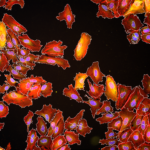Link to Pubmed [PMID] – 12366403
Cell. Microbiol. 2002 Oct;4(10):663-76
Brucella abortus is an intracellular pathogen that relies on unconventional virulence factors to infect hosts. In non-professional phagocytes, Rho GTPases-activation by the Escherichia coli cytotoxic necrotizing factor (CNF) promoted massive Brucella entrance by membrane ruffling, a mechanism that differs from the common mode of entrance used by this bacterium in non-treated cells. Cytotoxic necrotizing factor treatment, however, did not alter the intracellular route followed by the wild type or non-virulent defined mutants. In contrast, expression of a constitutively active Rab5Q79L GTPase did not alter cell-invasion by Brucella but hampered its ability to reach the endoplasmic reticulum. The CNF-induced Brucella super-infection did not reduce the ability of host cells to synthesize DNA and progress through the cell cycle. Furthermore, CNF-treatment increased the isolation of Brucella-containing compartments by a factor of 15. These results demonstrate that in non-professional phagocytic cells, Brucella manipulates two different sets of GTPases during its biogenesis, being internalization and intracellular trafficking two consecutive but independent processes. Besides, CNF-induced super-infection demonstrates that Brucella does not interfere with crucial cellular processes and has shown its potential as tool to characterize the intracellular compartments occupied by this bacterium.

